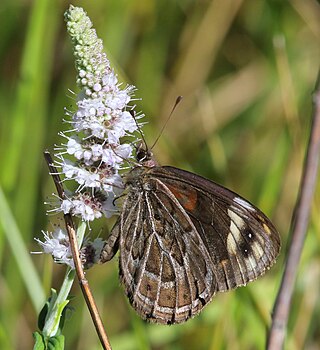
Pieris brassicae, the large white, also called cabbage butterfly, cabbage white, cabbage moth (erroneously), or in India the large cabbage white, is a butterfly in the family Pieridae. It is a close relative of the small white, Pieris rapae.

Ypthima asterope, the African ringlet or common three-ring, is a species of Satyrinae butterfly found in most dry areas of Africa and Asia.
Dingane ka Senzangakhona Zulu, commonly referred to as Dingane or Dingaan, was a Zulu chief who became king of the Zulu Kingdom in 1828.

Zizeeria knysna, the dark grass blue or African grass blue, is a species of blue butterfly (Lycaenidae) found in Africa, on Cyprus and the Iberian Peninsula.

Gegenes pumilio, the pigmy skipper or dark Hottentot, is a butterfly of the family Hesperiidae. It is found from the coasts of the Mediterranean Sea through Anatolia to the Himalaya and south in the whole of Africa.

Dingana is a butterfly genus from the subfamily Satyrinae in the family Nymphalidae.

Torynesis is a genus of butterflies from the subfamily Satyrinae in the family Nymphalidae. It comprises five species from South Africa and Lesotho. It is one of the genera in the tribe Dirini Verity, 1953; other genera of this tribe that are found in the Afrotropical Region are Paralethe, Aeropetes, Tarsocera, Dira, Serradinga and Dingana.
Dingana dingana, or Dingaan's widow, is a butterfly of the family Nymphalidae. It is found in the KwaZulu-Natal midfields from the Drakensberg foothills to the Mooi River.
Dingana angusta, the narrow-banded widow, is a butterfly of the family Nymphalidae. It is found in grasslands the eastern highlands from northern Eswatini to Mpumalanga and the Limpopo Province.
Dingana fraterna, the Stoffberg widow, is a butterfly of the family Nymphalidae. It is only known from one hillside to the south-west of the Stoffberg in the Mpumalanga province.
Dingana bowkeri, or Bowker's widow, is a butterfly of the family Nymphalidae. It is found in Lesotho, South Africa, in the Eastern Cape and Richmond and Cradock in the Cape Province.
Dingana clarki, or Clark's widow, is a butterfly of the family Nymphalidae. It is found in South Africa.
Dingana kammanassiensis, the Kammanassie widow, is a butterfly of the family Nymphalidae. It is only known from the slopes of the Kammanassie massif near Uniondale in South Africa.

Sevenia boisduvali, the Boisduval's tree nymph, is a butterfly in the family Nymphalidae. There are four subspecies; all native to Africa.

Anthene definita, the common ciliate blue or common hairtail, is a butterfly of the family Lycaenidae. It is found in southern Africa.

Cacyreus lingeus, the common bush blue or bush bronze, is a butterfly of the family Lycaenidae. As with other Cacyreus species it is endemic to the Afrotropics.

Pseudonacaduba sichela, the African line blue, dusky line blue or dusky blue, is a butterfly of the family Lycaenidae. It is found in Africa, south of the Sahara.
Lepidochrysops tantalus, the king blue, is a butterfly of the family Lycaenidae found in South Africa.

The Wolkberg is a mountain range in Tzaneen, Limpopo Province, South Africa. It is a northern termination and a subrange of the Drakensberg mountain range which lines up from Eastern Cape, Lesotho, Kwazulu Natal and Mpumalanga. At 2200 m (7200 ft) above sea level, it is the highest mountain range in Limpopo, together with the Iron crown mountain. Its Meteorological significance is that it brings along cold fronts and is a source of cold winters throughout the Limpopo province, the cold front gets transferred from greater Drakensberg mountains in Kwazulu Natal all the way to the Wolkberg. Without the Wolkberg, Limpopo will not experience cold winters at all. The range extends for about 30 km (19 mi) in a NW/SE direction north of Sekhukhuneland. The nearest towns are Haenertsburg and Tzaneen.










